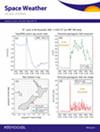Observations of Geomagnetic Crochet at High-Latitudes Due To X1.5 Class Solar Flare on 3 July 2021
IF 3.7
2区 地球科学
引用次数: 0
Abstract
On 3 July 2021, an X1.5 solar flare from the National Oceanic and Atmospheric Administration solar Active Region AR12838 (24°N, 88°W) occurred at 14:18 UT, peaked at 14:29 UT, and decayed at 14:34 UT. The study of this X1.5 solar flare is significant due to its unique geomagnetic crochet feature at high latitudes and its effective signature on Earth. The study examined X-rays, the extreme ultraviolet spectrum, ionospheric equivalent current (IEC), and geomagnetic field components. The study reveals a sudden increase in IEC during the X1.5 flare episode, forming a zonal current region and producing a geomagnetic crochet signature in geomagnetic field components at high latitudes (50°–80°N) along the 11°–26°E longitude sector during the flare peak time. All three geomagnetic field components show different sensitivity to the solar flare effect (sfe), and the amplitude and phase of the geomagnetic crochet across latitudes (for a given longitude) are consistent with the variations in the IEC. The present study is the first to appraise geomagnetic crochets of low magnitude (8–40 nT) and short duration (10–15 min) at high latitudes, particularly in the polar cusp region, during the X-class limb flare.2021 年 7 月 3 日 X1.5 级太阳耀斑引起的高纬度地磁钩编观测数据
2021年7月3日,美国国家海洋和大气管理局太阳活动区域AR12838(北纬24°,西经88°)发生了一次X1.5太阳耀斑,发生在世界标准时14:18,在世界标准时14:29达到峰值,在世界标准时14:34衰减。对这一 X1.5 级太阳耀斑的研究意义重大,因为它在高纬度地区具有独特的地磁钩编特征,并对地球产生了有效影响。研究考察了 X 射线、极紫外光谱、电离层等效电流 (IEC) 和地磁场成分。研究显示,在 X1.5 耀斑发生期间,电离层等效电流突然增加,形成了一个带状电流区,并在耀斑高峰期沿 11°-26°E 经度扇形高纬度地区(50°-80°N)的地磁场分量中产生了地磁钩针特征。所有三个地磁场分量都对太阳耀斑效应(sfe)表现出不同的敏感性,而且地磁钩针的跨纬度(给定经度)振幅和相位与 IEC 的变化一致。本研究首次评估了 X 级边缘耀斑期间高纬度地区,特别是极尖区的低幅(8-40 nT)、短时(10-15 分钟)地磁钩。
本文章由计算机程序翻译,如有差异,请以英文原文为准。
求助全文
约1分钟内获得全文
求助全文

 求助内容:
求助内容: 应助结果提醒方式:
应助结果提醒方式:


